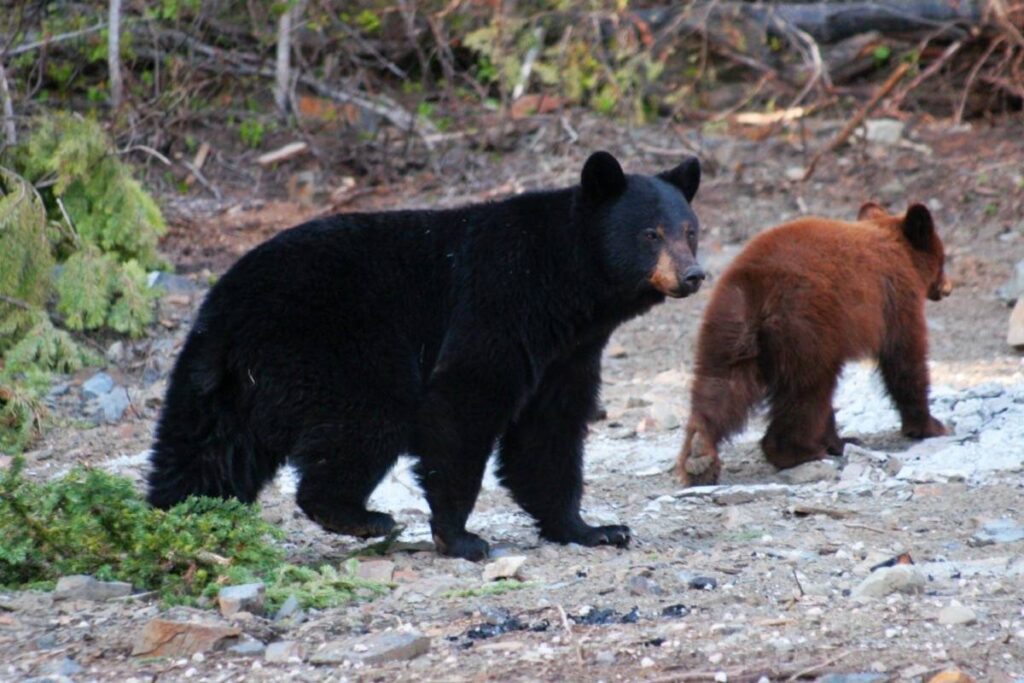We share many of our provincial parks with bears. BC is home to both grizzly bears and black bears. Bears are extremely sensitive to human disturbance and activity. Avoiding an encounter is the best way to protect both yourself and bears.
Before you go
- Pack bear spray, and learn how to use it
- Check the park web page for any specific information about bears in the area
- Look for notices about bears in the area when you arrive at a campground or trailhead
When camping
What attracts bears?
Ensure human and pet food, garbage, dirty camp stoves, recyclables, toiletries and all other smelly items are locked away in a metal bear-proof container provided in the park, your car or hung from a tree away from your campsite.
Dispose of grey water in designated areas, away from your camp site.
When on a trail
- Make noise. Don’t surprise a bear. Call, sing, clap or talk loudly especially near streams and in areas of low visibility.
- Be alert. Watch for bears or their scat and tracks, any strange smells or disturbed vegetation. Be aware of wind direction and speed. Extra caution is warranted when the wind is facing you.
- Stay together. Hike and bike in groups and don’t let children wander. Larger groups (4 or more) are less likely to have a negative bear encounter.
- Watch your pets. Keep your dog on a leash at all times. Dogs can provoke defensive bear behaviour.
- Use officially marked trails. Travel during daylight hours. Bears are most active at dawn and dusk.
- Carry bear spray and know how to use it.

Bear Scat
In the backcountry
- Use safe campsites
Designated campsites are the best option. If there are no designated sites, choose campsites that are away from bear sign and obvious bear foods like berries, waterways or other features that may be travel routes for wildlife. bear-proof canister
- Ensure food is stored safely
Use bear-safe food storage lockers. If there are none available, hang food by a rope system or from a tree branch in an area inaccessible to bears (at least 4 meters off the ground and 3 meters from the nearest tree). Consider using a bear proof canister as an alternative to hanging food.
- Use the triangle approach
Set up your tent, cooking area and food storage areas in a triangle pattern, about 50 m apart.

The triangle approach. Graphic: Parks Canada
If you encounter a bear:
- Stay calm. If the bear sees you, talk in a low, calm voice and then regardless if it has seen you or not.
- Back up slowly. Never turn your back on a bear, or run. Running could trigger an attack.
- Do not stare. The bear will see a direct stare as a challenge.
- Give it space. Make sure it has a way to get away, and that you are not blocking access to a bear’s cubs or its food.
If a bear approaches you or charges:
- Do not run!
- Use your bear spray as it approaches:
- Make sure you know how to use bear spray
- Play dead or fight back:
- Defensive attack – Usually, bears charge or attack because they are feeling threatened. Use your bear spray. If you don’t have bear spray and the bear makes contact with you – roll on your stomach, cover the back of your neck, remain still and play dead, they will lose interest and leave. Do NOT run!
- Predatory attack – In rare cases, a bear may see a human as prey and stalk you along a trail. In these cases, try to escape into a building, car or up a tree. If you cannot escape and the bear charges, use your bear spray, lacking that, use anything at your disposal to fight off the bear (rocks, sticks, hiking poles).
Read more about bear behaviour, and how to know if a bear is defensive or predatory.
Who’s who? Learn about the differences between black and brown bears.

- Never store food, toothpaste, perfumes or items that have any odour in your tent
- Never feed a bear
- Never approach a bear
- Never get between a mother bear and her cubs
THIS BLOG IS A REPOST FROM BC PARKS


